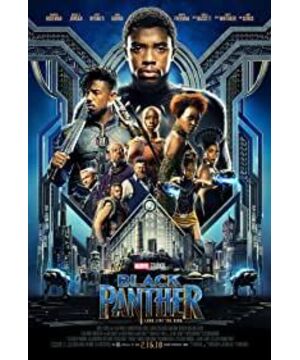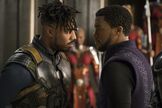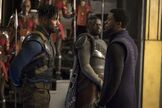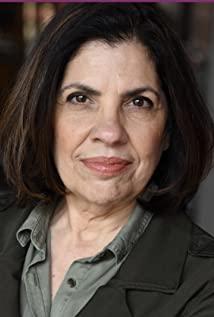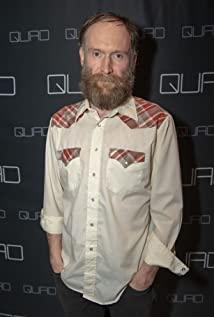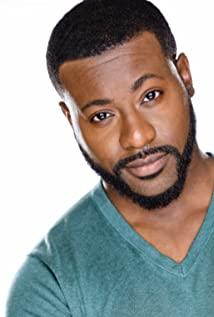"Black Panther" uses "African Futurism" to make Western audiences see one thing clearly: Imagining the future is not just the right of certain people.
?????
On the map of Africa, head east along the Congo Basin and find the dense jungle in the southern part of the Ethiopian plateau. There is Wakanda.
Now, imagine a wonderland that Western colonists have never set foot in—no plunder, no racial hatred, endless airships, frequent medical miracles, and the exploitation of rare substances "vibration", making it the most powerful country in the world.
This scene is like saying that if you haven't destroyed it, Africa will become like this.
In "Black Panther", people of African descent are imagining what they will look like 10, 20, or even 1,000 years from now.
What kind of miracle would be born if there were no ravages of war, colonization, hunger and poverty, the oldest birthplace of human civilization on this blue planet?
The answer is a future we never imagined.
?
Secret History of Wakanda
-Energy: gold flows everywhere there
Wakanda is an imaginary African country in "Black Panther", whose wealth comes from "vibration." This imaginary metal can power weapons and clothing.
In the traditions of indigenous peoples in Africa, one thing often has multiple uses. If you see someone wearing a beautiful cloth, the cloth may not only protect the body, but also rely on the fabric to record culture and history.
Based on this characteristic, the Wakanda people's battle clothes have both aesthetics and functionality.
The slightly shimmering silver luster on the Panther suit is inlaid with vibrating gold to withstand bullets and explosions.
The border tribes wore blankets, and the vibrating patterns turned the fabric into shields.
All of the above technical work is a masterpiece of a woman: the sister of King Techara, Princess Su Rui. This girl is Wakanda's "Elon Musk", as the chief technology officer, responsible for the research and development of various black technologies.
Her gloves can use the power of vibrato to launch shock waves, and the coolest work may be the ring blade of the warrior Nagiya.
-Costumes: They wear "full costumes" all year round
Costume designer Ruth Carter said that the costumes in this film are wisdom borrowed from residents of the entire African continent.
I have to admit that Africans have a god-given talent for the use of colors and patterns.
Carter designed a raised triangular dark pattern all over the body for the "black panther suit". She believes that the triangle is the geometric figure that best represents African culture, which makes Techara not only a superhero, but more like a king, the king of Africa.
This tribal elder in an emerald suit wears a matching lip plate, a body decoration found in the Suri and Mursi tribes of Ethiopia.
The drape of the border tribe is the traditional dress of the shepherds of Lesotho in South Africa. They graze on the plateau all year round, and their bright and thick blankets and boots help protect their bodies from the cold.
The Royal Women's Guard wears red tabards, neck loops protect their necks and show their status.
Embellished with beaded fabrics, referencing the beadwork of East African Maasai women, which can be passed on by soldiers to their daughters.
Lupita Nyong'o, who plays Nagia, said that in this film, cultural diversity is very useful. You can imagine their lifestyle by looking at the clothes. This is part of the role.
-City-a golden wonderland deep in the dense forest
The Golden City is the capital of Wakanda. It has two main types of public transportation: rail cars and maglev trains, both of which satisfy people's illusions about future trains.
Of course, with the help of Zhenjin, the power of the vehicle is much greater than in the real world.
There are three main types of aircraft in Wakanda:
Talon Fighters, similar to fighters.
Dragon Flyers is a dragonfly bionic helicopter.
Royal Talon Fighters is Wakanda's "Air Force One", and its top view is inspired by African masks.
The sparkling glass skyscrapers are derived from African architecture, and the traditional thatched roofs are kept above them. The scaffolding of the Timbuktu building and the Mali Pyramid are also reference objects.
Like many African countries, Wakanda divides its administrative regions into tribes, each of which has its own decoration and representative color.
Art director Hannah Beachler wrote a more than 500-page setting bible, in which the merchant tribe was inspired by the Berbers of the Sahara Desert. The mining tribe is modeled after the Himba people of Namibia, known for their hair accessories and bodies covered in red mud.
?
The future belongs to Africa
"Black Panther" is popular on the Internet with its unique aesthetics, thanks to the African-American actors and creative team (which is very rare in American movies) overturning contemporary science fiction favored Western design.
Putting the black race at the center of the future world is actually a trend of thought born in the 20th century, called "afrofuturism". It spans science fiction literature, music, art, and mythology, combined with the technology of the time, and imagines the future of mankind from the perspective of African descent.
The writer Mark Dery coined the term "African Futurism" in an article called "Black to The Future" in 1994. He quoted at the beginning of the article "Whoever controls the past is equal to control the future; who controls the present is equal to control the past", and then questioned:
Why are so few African Americans writing science fiction?
Why are black people almost invisible in the world of tomorrow depicted by Disney, Marvel, and Hollywood?
Why does the future belong to white people?
Indeed, science fiction, especially the American science fiction in the golden age, often coded colonial people and their culture as "aliens" or "others."
For example, in the old version of "Star Trek," the Klingon had a Fu Manchu face and was known for being brutal and rude.
The sand people in "Star Wars" are dressed in Arab-style robes, and they are not an easy race.
Unfortunately, this tradition continues to this day. The alien tribes in "Avatar" and "Interstellar Agents: City of a Thousand Stars" are nothing but a mixture of Native Americans and Africans.
Black Panther was born in 1966 and was co-created by Stan Lee and Jack Kirby. Although the meta-narrative was rooted in New York, it was initially interspersed with many stereotypes of Africa, but later began to study Wakanda’s in depth from the perspective of globalization. Geopolitics.
The film version of "Black Panther" goes a step further, truly portraying a superhero from a "pan-African" perspective, intertwining Wakanda's advanced technology with African civilization, and deconstructing Africa's tribal culture, artistic style, and life. Way, social form...
For example, in Wakanda, tradition and innovation are not mutually exclusive. The country’s ancient culture and its 21st century advanced technology are developing in parallel.
However, in the real world, post-colonialism tends to give priority to Western philosophy and design, and does not allow traditional culture to fulfill its potential. It seems that there are not too many African shadows in the communications officer of the company, Uhura; go on the street. In a circle, few African Americans knew their origins.
When people of African descent are invisibly enslaved in the United States or their own territory, they are also deprived of their African language and identity.
Wakanda is not affected by any particular African culture. In the Marvel Universe, it is a colony of African immigrants around the world. Priority is given to "non-white", "non-Western ideologies" and black Americans in the design. subculture.
Black Panther is both a returning king and a superhero. This character and his true identity are not as separate as the "superhero in the Western individualism paradigm".
Although Batman is a city hero, he is also an upper-class celebrity who has inherited a wealth of wealth and cannot resonate with white readers.
However, the Panthers are passed on through uninterrupted blood ties. This is the result of the integration of Western superheroes with tribal civilization, which reminds them of their roots, a luxury that African-American readers rarely get.
It is undeniable that the Black Panther is the best example of "African Futurism" in recent years.
?
Woman, cheetah, pyramid and stars
William Gibson once made a precise prediction: the future has arrived, but it is not evenly distributed.
In other words, the future will ignore the minority and is biased.
But now, the descendants of Africa are conceiving a new world of tomorrow, using their language to tell the story of women, cheetahs, pyramids and stars.
In addition to "Black Panther", a series of science fiction novels, music, costumes and artists from the African continent can all prove this.
In the album "Lemonade" last April, Beyoncé led a team of women in ethereal white dresses to establish a utopia of black women.
In the ending song "All the stars" sung by Kendrick Lamar and SZA for "Black Panther", four Nubian idol-like women descend from the sky like alien messengers, standing in a golden suspended temple.
The originator of "African Futurism", the artist Sun Ra called himself a messenger from Saturn, dressed in futuristic ancient Egyptian costumes, and used electronic synthesizers and jazz to tell the story of the universe.
Rapper Killah Priest’s single "From Past to Present" is based on the theme of time travel and also dates back to the time of the Pharaohs:
Memories erased from the slave ship
I saw my princess in the distance
Hold the baby and burn the incense
...
We used to wander among the mallows
In the past we shepherd the sheep, now we fight
The 2016 Nebula Awards awarded the best novella to African-American writer Nnedi Okorafor's "Binti".
In the book, a girl named Binti is a Simba from Namibia. She is admitted to the interstellar school and uses the ancient technology brought by the earth to carry out a series of adventures.
Of course, it also includes "Black Panther", which depicts many black women. Nominally, Wakanda’s hero is King Techara, but his bodyguards, consultants, and chief technologists are all women.
"Wired" magazine even commented: In the Panthers, the future belongs to women.
However, the future in the eyes of people of African descent should not fall into a certain aesthetic paradigm, nor does it need us to define it.
Each of them is a unique entity, opening up their own space in popular culture and contemporary history.
Science fiction writer Tochi Onyebuchi wrote after watching "Black Panther":
"African Futurism is like that chariot turned into a spaceship. We are no longer the aliens whose homes have been invaded, and we are no longer the targets of genocide by outsiders.
No, we are explorers, we can drive a spaceship.
The history of African Americans has been systematically destroyed, and we must reshape ourselves with a blank slate. We took our street hip-hop and slang with us, and draped funk-style, gem-studded blankets on our shoulders.
We can move freely into the future and become citizens of the universe. "
At the end of the film, Wakanda decided to announce his existence to the world and share advanced technology.
A UN official asked: What can a country full of farmers bring to the world?
King Techara laughed and said nothing.
Compilation source:
https://mashable.com/2018/02/14/history-of-afrofuturism-black-panther/#TWlCCqAHdsqW
https://www.wired.com/story/black-panther-design/
? | Keywords | Black Panther # # # Man Wei # # tile Canda #
?| Responsible Editor | Seaway
?| Compile|Captain
?| Author|Siddhant Adlakha, Angela Watercutter
View more about Black Panther reviews


